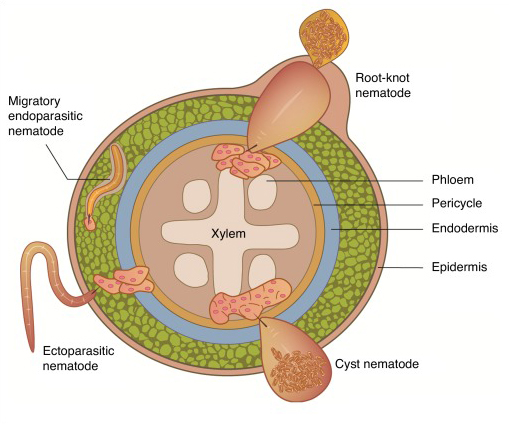File:Plant-parasitic nematode feeding types.jpg
From Wikimedia Commons, the free media repository
Jump to navigation
Jump to search
Plant-parasitic_nematode_feeding_types.jpg (509 × 424 pixels, file size: 153 KB, MIME type: image/jpeg)
File information
Structured data
Captions
Captions
Add a one-line explanation of what this file represents
Summary[edit]
| DescriptionPlant-parasitic nematode feeding types.jpg |
English: A cross section of a root illustrating the different feeding habits of sedentary and migratory nematodes. In general, plant-parasitic nematodes are categorized as endoparasitic, where they spend one or more of their life stages embedded in the plant tissue, or ectoparasitic, where the nematodes remain outside the plants to feed from plant cells. Examples of ectoparasitic nematodes include needle nematodes (Longidorus spp.) and dagger nematodes (Xiphinema spp.). The endoparasitic nematodes can be subdivided into sedentary or migratory nematodes. The sedentary endoparasitic nematodes include the root-knot (Meloidogyne spp.) and cyst (Heterodera and Globodera spp.) nematodes. These nematodes enter the plant roots as second stage juveniles. They travel to the plant vasculature and remain inside the root as they establish their permanent feeding sites. After molting three times, the adult RKN and CN females are enlarged and globose. The females lay their eggs in a gelatinous matrix (RKN), or retain the majority of eggs within the body of the female (CN). The migratory endoparasitic nematodes enter plant tissues but do not establish permanent feeding sites. They destructively migrate and feed from plant cells. An example of a migratory endoparasitic nematode are root lesion nematodes (Pratylenchus spp.). Aside from the eggs shown within the cyst nematodes, the nematode drawings only represent their general three-dimensional, external body structure; not drawn to scale. |
| Date | |
| Source | Vieira P. & Gleason C. (2019). Plant-parasitic nematode effectors — insights into their diversity and new tools for their identification. Current Opinion in Plant Biology 50: 37-43. DOI 10.1016/j.pbi.2019.02.007. |
| Author | Paulo Vieira & Cynthia Gleason |
Licensing[edit]
This file is licensed under the Creative Commons Attribution-Share Alike 4.0 International license.
- You are free:
- to share – to copy, distribute and transmit the work
- to remix – to adapt the work
- Under the following conditions:
- attribution – You must give appropriate credit, provide a link to the license, and indicate if changes were made. You may do so in any reasonable manner, but not in any way that suggests the licensor endorses you or your use.
- share alike – If you remix, transform, or build upon the material, you must distribute your contributions under the same or compatible license as the original.
File history
Click on a date/time to view the file as it appeared at that time.
| Date/Time | Thumbnail | Dimensions | User | Comment | |
|---|---|---|---|---|---|
| current | 09:21, 23 February 2021 |  | 509 × 424 (153 KB) | Yerpo (talk | contribs) | Uploaded a work by Paulo Vieira & Cynthia Gleason from Vieira P. & Gleason C. (2019). [https://www.sciencedirect.com/science/article/pii/S1369526618301134 Plant-parasitic nematode effectors — insights into their diversity and new tools for their identification]. ''Current Opinion in Plant Biology'' 50: 37-43. DOI [https://doi.org/10.1016/j.pbi.2019.02.007 10.1016/j.pbi.2019.02.007]. with UploadWizard |
You cannot overwrite this file.
File usage on Commons
There are no pages that use this file.
File usage on other wikis
The following other wikis use this file:
- Usage on en.wikipedia.org
Metadata
This file contains additional information such as Exif metadata which may have been added by the digital camera, scanner, or software program used to create or digitize it. If the file has been modified from its original state, some details such as the timestamp may not fully reflect those of the original file. The timestamp is only as accurate as the clock in the camera, and it may be completely wrong.
| Width | 513 px |
|---|---|
| Height | 428 px |
| Bits per component |
|
| Pixel composition | RGB |
| Orientation | Normal |
| Number of components | 3 |
| Horizontal resolution | 113 dpi |
| Vertical resolution | 113 dpi |
| Software used | Adobe Photoshop CS6 (Windows) |
| File change date and time | 10:10, 23 February 2021 |
| Exif version | 2.21 |
| Color space | Uncalibrated |
| Unique ID of original document | 2E5BF7E6DF731ED0474D49EC48E4984E |
| Date and time of digitizing | 14:58, 16 February 2021 |
| Date metadata was last modified | 11:10, 23 February 2021 |
| IIM version | 15 |
